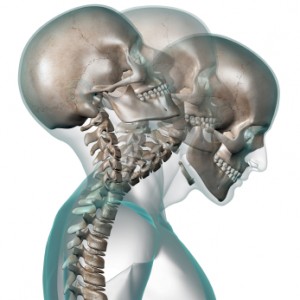Dr. John Mooney on Whiplash Basics:
I see whiplash injuries virtually every day in my practice. For me, this type of injury remains one of the more complex and serious conditions that I treat. For those afflicted with this condition, “whiplash” remains a term that may be forever associated with pain and suffering.
To understand why whiplash can be such a devastating affliction, one needs to better understand what a whiplash really involves.

Whiplash results from a sudden change in the movement of the head and neck relative to the rest of the body. Normally this movement is described in terms of acceleration (speeding up) and/or deceleration (a slowing down). If these movements occur in a relatively gradual manner, then the head and neck do not move with a whip-like motion. However, if the speeding up and/or slowing down process is too rapid for a person to adapt to, then a whipping motion of the head and neck occurs. If this whipping occurs beyond the normal range of motion of a joint, the injury can happen.
This whipping motion, or whiplash, can occur from auto accidents, slip and falls, sports injuries, and almost any endeavor that involves a sudden jarring to the body. A whiplash, though, typically occurring in a backward to forward plane of motion, can actually occur from many different angles. This whipping can occur even when the intensity of the jarring is relatively low.
A whiplash can do substantial damage to the body. This damage comes in two forms. The first is bone damage, such as fractures. The second involves soft tissue damage, which covers every other type of tissue in the body.
Most commonly injured by the whiplash is the supporting soft tissues of the head, neck, shoulders, and jaw. These tissues include the muscles and tendons (tissues that provide movement), ligaments (tissues that prevent excessive motion), cartilage (tissues that act as cushions and allow smooth motion in a joint), the blood vessels (conduits for nutrients to the area), and the nerves (message transmitters to and from the brain).
As an accident reconstructionist, Dr. John Mooney specializes in diagnosing and treating soft tissue injuries, especially those resulting from auto accidents. Also, as a respected expert in soft tissue trauma, he is often called upon to provide second opinion evaluations on those individuals injured at work or as a result of automobile accidents.
If you have sustained a personal injury when involved in an accident don’t wait to call. CALL (530) 622-3536 for an appointment, evaluation, and treatment today.
“Whiplash Basics” from the booklet “©Whiplash” by John M. Mooney, DC
Learn more:
- Whiplash Basics – Unlike other injuries breaks the rules
- A Closer Look at Whiplash
- View the Whiplash Videos
Additional sources of whiplash information can be found on this website.